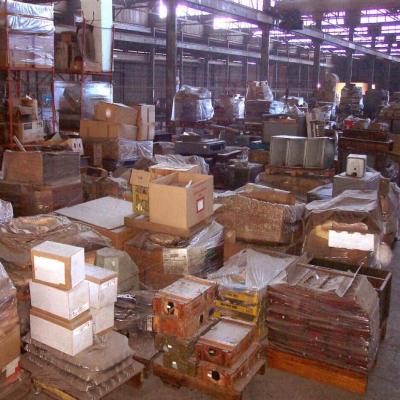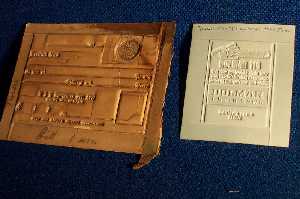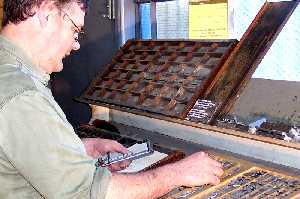![Melbourne Museum of Printing [36pt Old English]](../../-pix/mmolde36.gif)

36 MORELAND STREET FOOTSCRAY :: P.O. BOX 555 :: TEL (03) 9689 7555
GALLERY OF FOUNTS, SEPTEMBER 2003
The Museum's collection of founts includes thousands of
founts of printing types and thousands of founts of matrices
for making type.
- USAGE OF TYPE and TYPES:
When talking of lots of letters, either in the typecase or made up
ready to print, it is normal to use the word type as a
collective noun, that is, no s. So, I bought a fount of type,
containing 1000 pieces overall; we have many cases of type; she
used some large wooden type. or We worked all night setting the
type for the newsletter. This would apply whether the type was set
with individual letters or on the Linotype system which produces
complete lines as one piece. The composed matter is called type.
However when referring to the individual pieces of type, the plural
form is often used but it seems to be optional. For example I have
in my hand a few types from that new fount. Sometimes the plural is
used for the purpose of clarity as (above) thousands of founts of
printing types to indicate to a variety of readers, some less used
to these things, that a fount is a collection of individual pieces.
In several instances, the Museum's holding includes all the founts on
hand at a particular printery at the time of their closure.
The founts of matrices (abbr. mats) are of two basic kinds:
those used for casting individual letters and those used for casting
complete lines. The latter founts must contain enough of each character
to compose any required text, whereas those for casting single types
need only one of each character.
| Some of these examples are
safely in the Museum's venue. They are fascinating and tell wonderful
stories, but the venue can hold less than 5% of the Museum's
world-unique collection. It is a matter of some grief that the rest,
including the world's only large collection of typesetting machinery
and the only collection of its kind of printing documents and
artefacts, are not being protected by the authorities or industry and
are in danger of being scrapped. |
|
THE 95% THAT'S IN STORAGE AND IN JEOPARDY . . . |

ENLARGEMENT? SEE JUNE PICTORIAL (DOWNLOADS)
| << View over some 20% of the Museum's collection of
documents and artefacts, boxed and palletted in the store, including
many like those above. The artefact collection, if it survives the
present crisis, will allow researchers a detailed view of what was
being printed mid to late 20th century, and how it was
printed. |

ENLARGEMENT? SEE JUNE PICTORIAL (DOWNLOADS)
Some of our thousands of stereotype matrices, from which stereotype
plates were cast. Stereos (and electrotypes) were a way of making
multiple copies of the same printing type or block.
|
|
The Museum is seeking assistance with the cost of protecting the
stored collection for the next four years. Revenues should then be
sufficient for ongoing storage. Without support, this world-class
collection is almost certainly destined for destruction.
|
|

